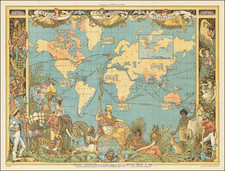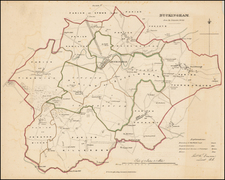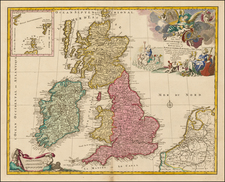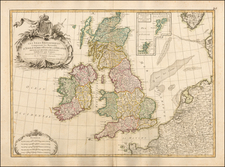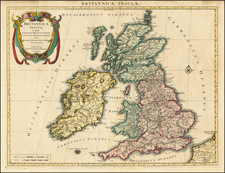Decorative example of this scarce large-format map of London, published at the end of the 17th Century by Morden, Lea and Browne.
The map extends from St Pancras in the north to Southwark, and from Arlington House (Buckingham Palace) in the west to Stepney in the east.
The map is embellished with London's coat of arms and a decorative banner with information promoting the business locations of Lea and Browne, the surviving sellers. As noted in the catalog entry of Daniel Crouch Rare Books:
The most important public buildings are shown in elevation. Amongst them are some notable lost palaces, including Arlington House, on the present day site of Buckingham Palace. The house, built in 1675, was the residence of Henry Bennet, 1st Earl of Arlington. The freehold for the property would be sold to the Duke of Buckingham in 1702. Another palace of note is Montague House, home of the 1st Duke of Montague. It was situated on Great Russell Street, which at the time backed on to fields, and in 1759 was sold to the Trustees of the British Museum. The house would be demolished in the 1840s to make way for the modern day building. A great deal of the outlying area of the map is a patchwork of fields dotted with hamlets, such as Marylebone, St Pancras, and Cambridge Heath. Below the plan are tables giving names of the public offices, wards, and parishes; which before the Fire numbered 97 but only 62 after. There is also information on the halls and companies, markets, inns of court, prisons, palaces, and public buildings. The Thames is depicted teeming with sailing vessels, barges and watermen.
A fascinating look at London, shortly after the Great Fire.
Robert Morden (d. 1703) was a British map and globe maker. Little is known about his early life, although he was most likely apprenticed to Joseph Moxon. By 1671, Morden was working from the sign of the Atlas on Cornhill, the same address out of which Moxon had previously worked. Most famous for his English county maps, his geography texts, and his wall maps, Morden entered into many partnerships during his career, usually to finance larger publishing projects.
Philip Lea (fl. 1683-1700) was a central figure in the London map community at the end of the eighteenth century. He apprenticed under Robert Morden, with whom he later collaborated. Lea was made free of the Weavers Company in 1689. He was a publisher and a globe and instrument seller with ties to members of government. For example, Samuel Pepys lists him as his map advisor and colorist. He was not known primarily for his own original works, but for his reworking and reissuing of the work of others, particularly the county maps and world map of Christopher Saxton. He also acquired plates from John Seller, John Ogilby, and William Morgan, among others. Later in his career, he collaborated frequently with Herman Moll. After his death in 1700, Philip’s wife, Anne, carried on the business for several decades.









![(Second World War - Italian Propaganda Poster) i 50 Sbarchi in Gran Bretagna
[The 50 Landings in Great Britain]](https://storage.googleapis.com/raremaps/img/small/86443.jpg)
